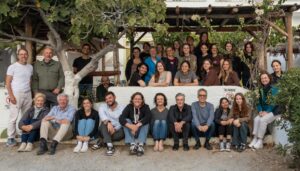
It’s a Wrap, Season Finale !
After six incredible weeks the 2024 Zagora Archaeological Project field season is coming to a conclusion this weekend as we prepare to say farewell to our second group of students and to many of our field specialists.
The settlement of Zagora, on the Aegean island of Andros, about two hours by ferry from mainland Greece.
Almost three thousand years ago, from around 900 BCE to 700 BCE.
The people of Zagora left around 700 BCE. We’re not sure why but it may have been that the water supply dried up and could no longer support them. The area was not resettled – which means that the buildings were left as they had been lived in. Zagora is like a snapshot in time.
Many other archaeological sites have been ruined by earthquakes, volcanic eruptions or the ravages of war. Or their architecture and artefacts portray a less clear picture due to successive periods of habitation by different peoples, obscuring or confusing the evidence of earlier habitation.
The settlement layout at Zagora – over 6.7 hectares – was not disturbed by subsequent settlement. The building materials weren’t used to modify the buildings or moved to make different structures with them, as is often the case where there have been successive settlements.
Of course not much remains standing after almost 3,000 years; the buildings collapsed where they had stood. But the building layout remains, along with objects and object pieces – mostly pottery, in the rooms where they had been stored and used. This provides clear evidence of how life was lived at Zagora – which is extremely rare among central Aegean Early Iron Age sites.
Much has been discovered even though only 10% of the site has been excavated – revealing 55 stone-built rooms. We wonder what our further exploration will reveal….

After six incredible weeks the 2024 Zagora Archaeological Project field season is coming to a conclusion this weekend as we prepare to say farewell to our second group of students and to many of our field specialists.
It was an Australian team, led by Sydney University Archaeology Professor Alexander Cambitoglou, that in the late 1960s and early 70s conducted (under the auspices of the Archaeological Society at Athens) the first major excavations of the site. This revealed much of the settlement layout, and many of the artefacts discovered are now in the Archaeological Museum of Andros.
In 2012, 40 years later, we returned to the site, thanks to an Australian Research Council (ARC) grant, to continue the exploration. The grant was awarded to the Department of Archaeology at the University of Sydney and the Australian Archaeological Institute at Athens. The Powerhouse Museum, the Archaeological Society at Athens and the Institute for Mediterranean Research (Crete) were major participants in this important project.
The 2012 fieldwork took place for six weeks from mid October to late November, and in 2013 and 2014 for six weeks from late September to early November.
The Zagora Archaeological Project utilises 21st century methods to add breadth and depth to our knowledge of this unique town. These are described in this website – see particularly the Zagora dig blog and For teachers sections.
In 2019, The University of Sydney’s Department of Archaeology in collaboration with GML Heritage, the Australian Archaeological Institute at Athens and Sydney University Museums are returning to Zagora for a three week season in July.
The aims of the 2019 season are to conduct archaeological excavations and a surface survey as well as explore subsurface remains with thermal/infrared imaging. A particular focus of the team’s attention in 2019 will be an area in which evidence for workshop – or even ‘industrial’ – activities were revealed in the latter stages of the 2014 excavation season. This was a find of major importance for Aegean, and wider, archaeology. The upcoming season promises to reveal new and important information which will help us understand the economy of the site and its place in the wider eastern Mediterranean.
Unless otherwise stated, the images and text on this website are licensed under CC BY-NC. Images to be attributed according to the copyright acknowledgement in the caption.